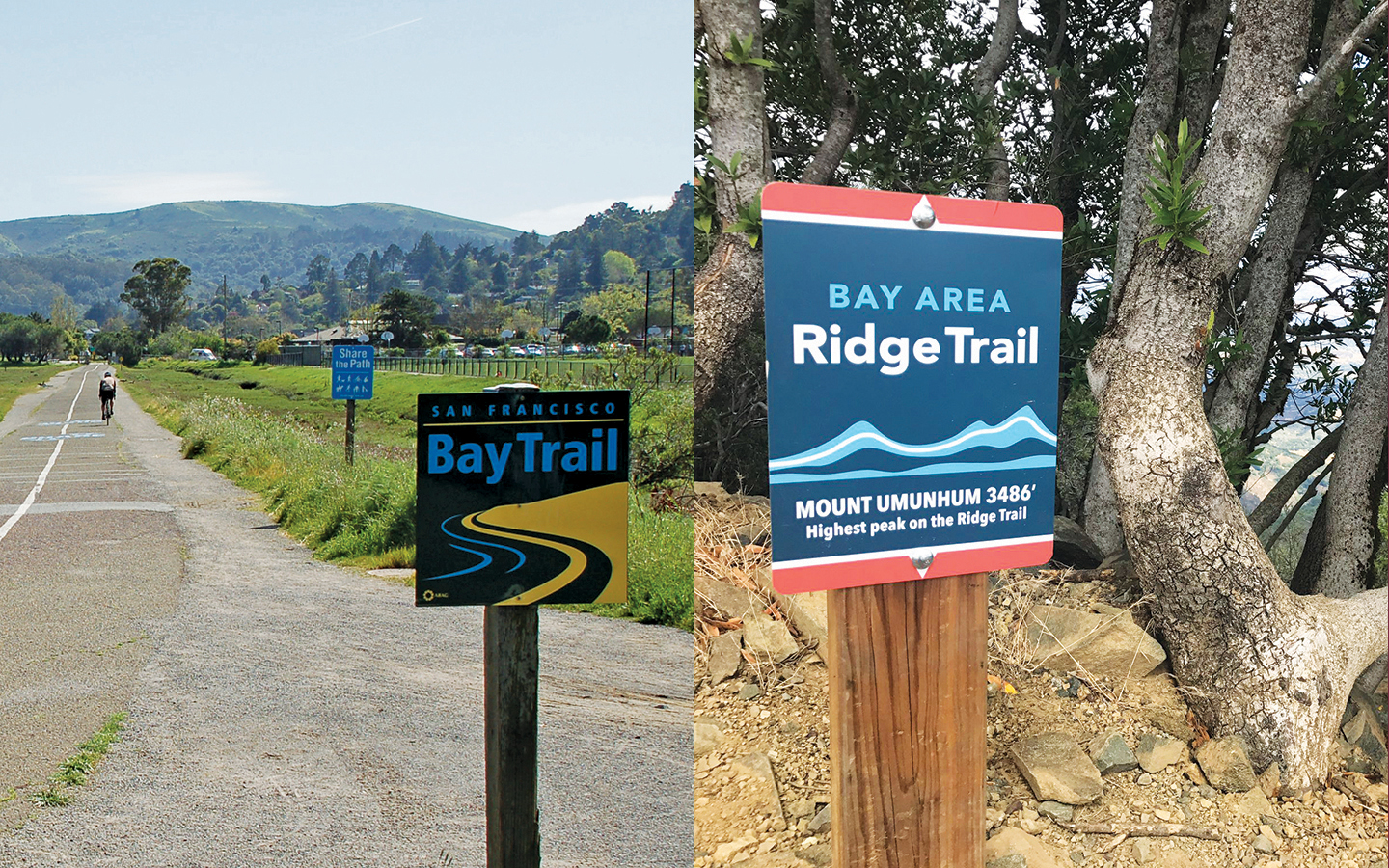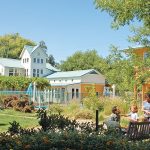
Planners were feeling ambitious in 1989, setting their sites on creating two massive Bay Area trails — one to ring the shoreline and another to loop around hill and mountain ridgelines. Today, after three decades, lots of fundraising, and plenty of hard work, more than 350 miles of the planned 500-mile San Francisco Bay Trail are complete, as are 375 miles of the planned 550-mile Bay Area Ridge Trail. With both projects reaching their 30th anniversary, outdoor enthusiasts are invited to hit the trails for various 2019 events. Visit baytrail.org and ridgetrail.org for more details. San Francisco Bay Trail photo by Alec MacDonald; Bay Area Ridge Trail photo courtesy Hunt Design.
With summer beckoning and some wildflowers still in bloom, it’s time to get out on the trails. Fresh on the heels of National Trails Day on June 1, people have extra momentum to keep hiking during the 30th anniversaries of both the San Francisco Bay Trail and the Bay Area Ridge Trail.
Those two massive projects represent just a fraction of our embarrassment of riches when it comes to trails — and we use what we have, too. It’s hard to know how many of the nearly eight million residents in our region use all our trails, but it’s safe to say that a high percentage of people keep them busy; add tourists, and they can get downright congested.
Most trails in the Bay Area are considered multi-use, which means they accommodate hikers, dog walkers, cyclists, people with limited abilities, and equestrians. Within these user groups, everyone travels at a different pace, and on trails managed by different agencies with unique user policies. Yet despite this variability, it’s a good idea for all of us to follow shared rules of the trail for safety and the protection of the environment. Although there are no universal rules of the trail, we can get close by following the Seven Principles developed by the Leave No Trace Center for Outdoor Ethics to minimize impacts on the outdoor world.
The first Leave No Trace principle is to plan ahead and prepare. Sergeant Lexi Jones oversees all the California State Parks in Marin County, including Mount Tamalpais State Park. “We have a fair number of lost hikers up here,” she said, referring to the popular Dipsea-Steep Ravine-Matt Davis loop trail. For a safe outing, she suggests that hikers pack extra water and snacks, allow plenty of time for the hike, and have knowledge of their return plan.
She also encourages the use of paper maps. Cell phone reception is spotty on the mountain, batteries die, and it can be difficult to orient yourself with the small screen on your phone. Every Sunday at Pantoll Ranger Station people ask Jones for directions as they shrink and enlarge the scale of the map on their phone. “Okay, here’s the ocean,” she tells them, pointing to the paper map she has unfurled on the hood of her car, offering them a point of reference before setting them on course.
The second principle is to travel on durable surfaces and stay on designated trails. It’s better for the environment, and safer for users because designated trails are the ones that are maintained.
It’s important that people stay on designated trails to maintain the integrity of popular preserves near urban areas. Among the 26 open space preserves managed by the Midpeninsula Regional Open Space District (Midpen), the trails at Fremont Older, Rancho San Antonio, and Windy Hill preserves are used daily. Like many agencies that offer public access on their land, Midpen manages their preserves in perpetuity. Before opening any land for public use, the agency goes through a rigorous process to determine what uses should be allowed based on public safety and the protection of the natural environment. Trails are diverted away from sensitive species and slopes that could fail, and trail users need to respect those decisions, said Midpen spokesperson Leigh Ann Gessner.
“Most people are self-regulated because they appreciate the open space access that we have in the Bay Area,” she said. “Just like driving, most people are courteous and respect the regulations that are there for a reason.”
The third principle is to dispose of waste properly. The dominant problem here is with dog walkers who leave used poop bags on the trail. It’s ubiquitous across the region. The East Bay Regional Park District reminds users that there is no “poop fairy” who walks the trails to pick up used poop bags. And it’s not just the bags, either. Dog waste, even when in the bushes, is not harmless as some might rationalize; it is different from wild animal scat, and affects water quality. “Good park users are stewards of the park, and good stewardship includes removing all dog waste, including the bags,” said the East Bay Regional Park District’s Dave Mason.
The principle of leave what you find, number four, is pretty straightforward. Don’t damage or take flora, and leave cultural artifacts alone. When you leave things of interest as you find them, it gives others the joy of discovery. You may have read about the hordes of people in Southern California who trampled and collected desert flowers during this spring’s super bloom. “In this day of social media and posting photos online, we realize that some people need a reminder of this ‘leave no trace’ principle,” said Midpen’s Gessner.
Leave No Trace’s next principle is related to campfires and not relevant to day-use of trails, but principle number six puts us back on track with a reminder to respect wildlife. From California newts to bald eagles, we are fortunate to encounter wildlife on our trails. The main tenets of respecting wildlife are to watch from a distance, don’t stress the animals by getting too close or being too loud, and, for their health and our own safety, don’t feed wild animals.
Horses and cattle are not wild, but since we encounter these large animals on the trail, we’ll fold in some helpful tips on sharing the path with them. Trail rules regarding horses are pretty easy. When you encounter an equestrian on a trail, stop and say hello, and ask the rider if it’s okay to pass. The sound of your voice will soothe the horse. In general, hikers yield to equestrians, and cyclists yield to hikers and equestrians. If you can do it safely, pass downslope of the horse.
Hiking with cattle is a common occurrence since seasonal cattle-grazing is used by land managers to reduce non-native grasses, minimize fuel load to help prevent fire, and support agricultural operations. The East Bay Regional Park District has grazing licenses on 67 percent of its property. Midpen uses conservation grazing on about 17 percent of its 63,000 acres, with two grazing areas that overlap with public trails at Russian Ridge and La Honda Creek preserves.
Most organizations offer tips on how to hike with cattle in brochures, on websites, and posted at trailheads. “Approach slowly, speak normally, and allow them to move away,” advises East Bay Regional Park District range manager Denise Defreese, although she acknowledges that with more people using the parks, cattle are becoming more comfortable with people and not moving away.
Cattle are prey animals. To keep them at ease, act like a prey animal too. “Don’t move towards them like a nimble-footed predator,” said Solano Land Trust’s rangeland ecologist Jasmine Westbrook during a hiking-with-cows workshop. “Instead, act like a lazy prey animal.”
When you find yourself close to cattle on a trail, Westbrook advises that you look around and away from them. “Stay calm, hydrate, and look at the flowers. Don’t clap or whistle to try and get them to move. If you’re on a bike, get off it to let them see you’re a person separate from the bike,” she said. “If you’re with a group of hikers, don’t walk single file on a trail. Cows see that as a pack of predators.”
The seventh principle is to show basic consideration of other visitors. Sergeant Jones said that the State Parks in Marin County promote the “slow and say hello” approach. The idea is to slow down enough to announce your presence and make a meaningful connection with other trail users. Perhaps it would be prudent to adopt the slow and say hello philosophy as the first principle for our busy trails.
Aleta George covers open space for the Monitor.

